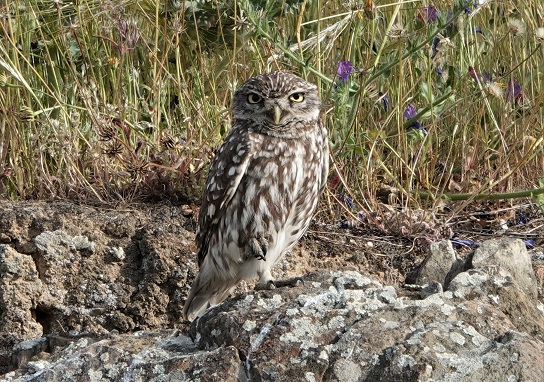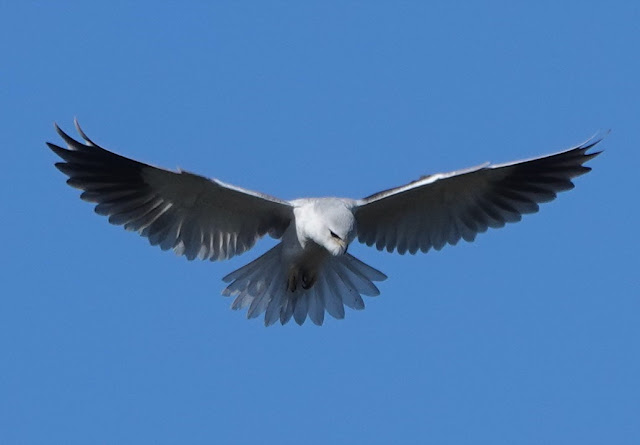Ben's 5000
Ben’s list
was unequivocal. An experienced birder who had travelled widely globally, this
was his first birding trip to Spain Spain Madrid
Ben was
joined by his friend Hans, who also had some targets including a couple that
were different from Ben’s. The stakes rose!
Ben the
previous evening had already seen Great Spotted Cuckoo and Azure-winged Magpie (species number one - see John Hawkins' photo above - and two) on his way to our house. Our first day
concentrated on the birds of the open plains. As I have referred to in recent
blogs, these habitats have been blighted by the drought this year. However, at
our first stop, singing Corn Buntings surrounded us and a pair of Iberian Grey
Shrike treated us with great views. Then we found a group of Little Bustard,
the third of the target species to be seen. Three of four males were in
full-breeding plumage with their black-and-white chevron necks. Just minutes
later, a small party of Great Bustard (species number four) flew past with
their slow, powerful wing beats. Others were to be seen over the next hour.
Just minutes later we were watching some Pin-tailed Sandgrouse (species number
five) which were initially stubbornly staying just in view on the skyline of
the field, but with patience we were rewarded with fine views of this
beautifully patterned bird as they fed.
We continued down a track, getting close views of Thekla Lark (number
six), seeing Crested Larks nearby to provide a comparison. Then several
Black-bellied Sandgrouse flew over, splendidly set against a clear blue sky:
species number seven, so far so good.
We explored
another area of plains where often one of the possible targets: Black-eared
Wheatears are present, but clearly we were still a bit too early in the season,
however more Black-bellied Sandgrouse were seen. Following a distant view of a
soaring Bonelli’s Eagle, but closer views of a Sardinian Warbler (species
number eight) we stopped at a river valley to look for Cirl Bunting. I got very
brief sightings of a pair on the ground and in a tree, but Ben saw only
movement, not “tickable” views. We went down the path again after lunch and
also drew a blank. We then decided to go to look for one of Hans’ species and
just a minute after getting out of the car at Montánchez castle we were
watching two confiding Alpine Accentors. It was a splendid afternoon there with
Alpine Swift passing overhead, Red-rumped Swallows, Blue Rock Thrushes and more
Sardinian Warblers.
The
following morning, off to Monfragüe
National Park
Ben felt
that for his last morning he would really like to get good views of Great
Bustards in display, rather than try again for Black-eared Wheatear on the
steppes, so we visited a favourite spot of mine. Quickly we found a group of
Great Bustards, but it looked as if they were not fully in the mood. Some males
looked as if they might start their extraordinary display, but seemed to give
up half way. Then we spotted a closer male, all on its own. He was a big,
brightly-coloured specimen and as we watched slowly it lowered its wings, its
neck inflated, it seemed to turn its wings and tail inside out, as it became a
huge white quivering ball, its orange neck now like a medicine ball, almost
touching the ground. Wow! As we left, we saw a group of Black-bellied
Sandgrouse and a Little Owl. We then headed to an area of scrubby habitat,
excellent for warblers. However, despite good views of Dartford Warbler and
Lesser Spotted Woodpecker in some nearby Cork Oaks, the hoped for- possibles:
Spectacled and Western Orphean Warblers, were not present – it was simply a
little bit too early in the spring for them. Then onto the mountains to try for
three remaining possible species. At our next stop we quickly found what we
were looking for, prolonged if distant views of a male Black Wheatear (species
number 12). But we waited and waited for
Cirl Bunting until, yes, one started singing. However, rather uncharacteristically
for the species, it was singing from rather deep in an oak tree and try as we
might all we saw was movement and then the bird flying off – again “untickable”
views for Ben. Was this species going to let us down? I wanted then to try for
Firecrest and we went to an area usually good for them. However, it was getting
a bit late in the season for them and when we arrived the area was busy with
roadworks. We spent a few minutes finding a quiet stretch of the road to walk
along, but no joy.
I had to
give up on this species, but felt that Ben could find this while birding north
of Madrid later, so we took one last chance
for Cirl Bunting, visiting a lovely stretch of the Almonte River
And so the
day ended, we had found all 13 species we were looking for, with the dates not
being right to pick up extras. Ben revealed that he was now just two species
short of reaching 5000 species on his life-list. Ben had two and a half of days
left in Spain Madrid





Comments